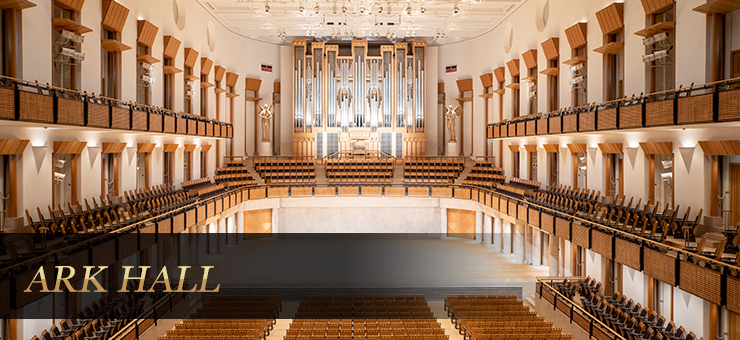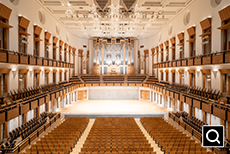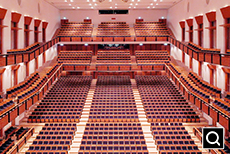
PIPE ORGAN
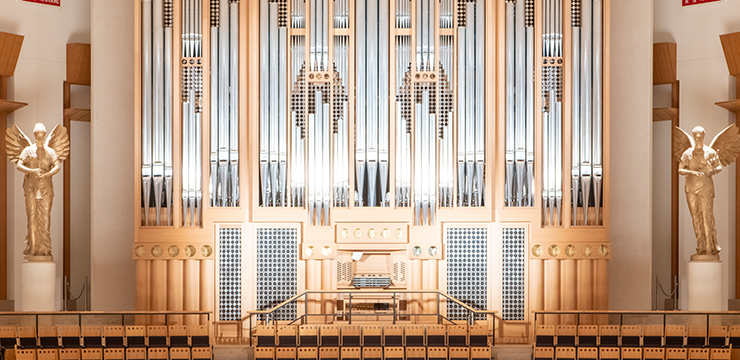
- The pipe organ at Ark Hall with a charm of affluent sound

“The pipe organ in its timbre and sound naturally expresses the individuality of the Hall. The Ark Hall is abundant with warmth of wood. Therefore, its pipe organ has a rich and longer sound with full of warmth.” The MUSE adviser and worldly active organist Naomi Matsui talked of the charm of the pipe organ at Ark Hall. The various sound and timbre of the “King of Instruments,” pipe organ, is produced in the combination of stops.

The Ark Hall's pipe organ has 75 stops. Each organist produces one's original timbre with combining these stops, and it is said that some organists keep secret how he/she combines the stops until his/her performance has started.Thus, the timbre of pipe organ varies with the combination of stops. On each stop, its name, assigned keyboard, feet pitch, and number are described. The organist, reading the descriptions, decides the combination of stops for performance. The computer is installed in the pipe organ at Ark Hall to memorise the stops' combination. Therefore, the organist is able to reproduce the pre-set combination by pressing a button. The Ark Hall pipe organ is manufactured by the world-renowned Rieger Company of Austria, who undertakes world-wide organ projects including the new organ of the Stephan Cathedral in Vienna, after one and a half year of work. The Ark Hall organ is the brother instrument to the one at Suntory Hall in Japan. Having two Swell keyboards, each of which have French and German symphonic sound, and equipped with 75 stops and 5563 pipes, the Ark Hall pipe organ is prominently one of the largest instruments in Japan.
The pipe organ consists of the console with keyboards and pedals (foot keyboards), and stops, the pipes in various sizes that make actual sounds, and the motor and the wind box that accumulates wind, both placed hidden.
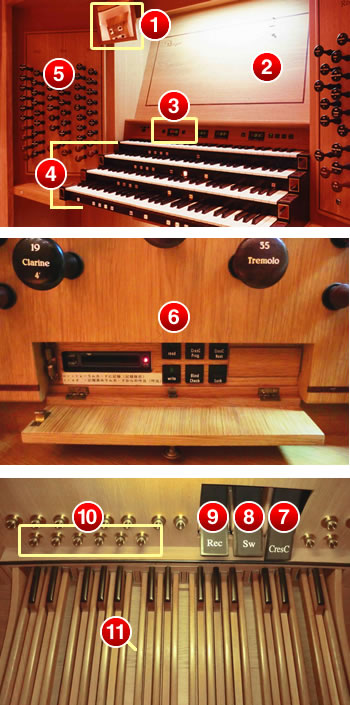
- The mirror for the organist to check the conductor's instruction in working with orchestra
- Music stand
- The computer to memorise the combination of stops
- Keyboard, numbered the first, second, third and fourth from the bottom to top
- Stops:
They are the switches to select sound qualities and timbres. The name, assigned keyboard, feet pitch and numbers are written on them. Selecting the combination of stops, an organist is able to create his/her own sound. - RAM card:
The organist's own sound produced with the stops' combination can fully be memorised in this RAM card. - The crescendo pedal is to adjust the volume with pre-ordered increase and decrease of stops.
- Open and close the door to adjust the volume of the fourth keyboard
- Adjust the volume of the third keyboard - this operation enables to crescendo and diminuendo.
Using this pedal, the shutters placed in front of the group of pipes will close and the volume diminishes. - The button to operate the memory devices with feet during the performance
- Pedal:
The fifth pedal having bass pipes are pressed with both feet. It has a register of 2 and a half octave extent.
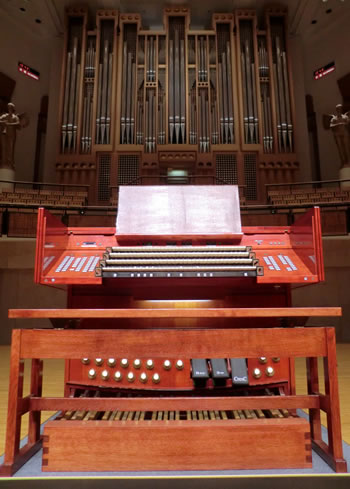
The console is connected to the body of organ with a thin electric cord. All the operation including the stop set-up and hitting keyboard is sent to the body of the organ as electric signals for performance, and the sound comes out of the pipes. The console is placed on the stage and used in the concert with orchestras.

- Inside of the organ case with various sized pipes - most of the pipes are made of metal, though some wooden pipes are included.
Seating Chart
Hall Overview
| Seating Capacity | 2,002 (1F/1,106, 2F/560, and 3F/336) |
|---|---|
| Measurements of the Seating Area | width/21.5m x depth/60.0m x height/18.0m |
| Seating Area | 1,573.5㎡ |
| Measurements of Stage | width/21.58m x depth/14.87m x height/17.0m (open stage) |
| Stage Area | 291.5㎡ |
| Reverberation Time (250Hz-2KHz) |
without audience/2.20-2.45sec. |
| Attached Facilities | Buffet, Drawing Room, Dressing Rooms (7, western style), and Orchestra Lounge |




